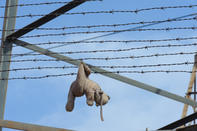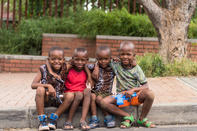Impatience of Youth
If the idea of creating Soweto was to keep black South Africans far away from the peaceful, sylvan white suburbs and to have it as a massive hostel and labour reservoir, then once again Pretoria had its own plans blow up in its face. Not many white South Africans have visited Soweto, but for them it is a place of foreboding and threat.

Rather than keeping it peaceably out of sight and mind, fear of this giant flexing its muscles has created a schizophrenic and paranoid society. One of the most significant things about June 16, 1976, and its aftermath was that with the impatience of youth, the children of Soweto (and consequently black youth throughout South Africa) passed a vote of no confidence in their parents. For the first time in the history of township resistance, no big-time politician featured.
None of the black political parties could claim credit for the education protest. The children knew that it was their show. They had tasted blood. They had tasted power and they liked it so much that they wrested it away from the established leaders. Press statements were issued by teenagers.
For the first time, politicians and civic leaders took a back seat as teenagers virtually took over the running of the country's largest townships. Some elderly black journalists who felt guilty that such an important issue had been left to the children to resolve, held talks with the student leaders.
The Township was Tense
'What you know about Bantu education is dangerously academic,' the students warned. 'You've never felt the pinch. Please leave it to the victims of this evil system to sort out, because the pangs of the system are real to us, we have felt them.' Things in the township were tense. The student leaders feared for the life of Mrs Juby Mayet, a fair-skinned Malay reporter who was later banned.
'Bra Stan' they said to Stan Motjuwadi, 'We know that Mrs Mayet is one of us, but please take her back to town. We cannot guarantee her safety because there are many who do not know who she is.' In the heat of the moment, she could have been mistaken by rioters for a white. Other white reporters who were known to support the black cause were also asked to get out of Soweto while anti-white tensions were running so high.
This was before the authorities ordered all whites, except members of the security forces, out of Soweto for their own safety. On the night of June 16, the only white person left in Soweto was Catholic priest Father Merino.. . not even the police stayed. This was the all-black Soweto that the architects of the apartheid system had dreamed of — but maybe God in his wisdom was showing them just how costly it would be to fulfil their fantasy.
United Nations
In the year of 1976, the youth of Soweto pre-empted the United Nations' Year of the Child. Baby talk gave way to articulate political voices; the children had matured overnight, nurtured by the power of their convictions, learning that they had the ability to shake up the country's stagnant political status quo. They did not ask to be given a hearing, they called the tune — and this youth symphony has been playing ever since.
Today it is no humiliation for top sports administrators, showbiz promoters and educationists in Soweto to play second fiddle to children. If an event clashes with a day of protest or mourning, the event is postponed. Popular shebeens, some the premises of powerful vice lords, close shop and even the most dedicated drunk goes dry when the students sing their song of protest.
On their own terms, the students are getting a live experience of their roles as future leaders — and in doing so they are forever changing the rules of the game.
Township Eruptions
In 1984/85 the black townships around South Africa once again erupted in a well-coordinated spate of student protests, rent and consumer boycotts, school and worker stayaways. So effective and widespread were they that the only way in which the government could combat this grassroots resistance was to declare a 'state of emergency' under which the police were given extra powers which circumvent the normal processes of law and order.
This was a time of violent boycott enforcement; of tyrannical but efficient street committees that replaced docile black leaders and brazenly confronted the police with AK47s; a time of sickening witch hunts and necklacing of 'sellouts' and informers, and of reactionary black backlashes, often with police protection and armed backup.
And yet at this time, Soweto was uncharacteristically subdued. Stayaways by Sowetans in white commercial, industrial and domestic jobs were unenthusiastic, consumer boycotts were slow to start, and the rent boycotts, in particular, started a year later than in other Witwatersrand townships.
Soweto's Biggest Problem
Had the government finally managed to intimidate and squash Soweto's once fiery spirit of protest; was the giant merely sleeping, or had the combination of repressive stick and economic carrot tamed and placated the people of Soweto? Certainly, the Draconian emergency regulations helped to force the lid down on the pot.
A total press gag of all unrest helped to give the impression that all was well in the land. In fact, the standard police reply was that they had 'no information' about anything other than calm and goodwill in the black areas — and this to black journalists who every day were waking up to the explosive sounds of 'emergency'.
But perhaps the carrot had also been bitten and the taste of sweet success had lulled many Sowetans into a lotus-eating stupor of material comfort. Without a doubt, the biggest visual change in post-1976 Soweto is the erection of new, middle-class housing and the renovations of the old 'matchbox' houses into respectable, comfortable residences throughout the city.
Until a few years ago lack of housing was singled out by residents as Soweto's biggest problem. Today they unanimously say it is violent crime committed by the vast army of unemployed and unschooled youths. While there are still vast, filthy squatter settlements in the heart of Soweto, no-one can ignore the sudden improvement in housing conditions there.
This has come about with the scrapping of the pass laws and influx control, increased black activity in the mainstream economy, and the fact that legislation now exists to enable residents to acquire full freehold or 99-year leasehold rights to their land.
Banks and building societies are falling over themselves in the rush to grant building bonds. (Every month Sowetans are being lent approximately R30-million for home improvements.) Quite as suddenly all but the most backward looking white businesses want a slice of the enormous 'black market'.
The Light of Freedom

While the political inactivity of 1984/85 was unexpected, Soweto did not fall asleep in overfed self-satisfaction. In May 1987 parliamentary elections were held to elect a three-tier government that includes the country's collaboratory Indian and Coloured populations but pointedly excludes all blacks.
The then two most powerful political groups in Soweto, Cosatu and the UDF, implemented a two-day work stayaway that brought Johannesburg's businesses and industries to an uncomfortable near-standstill. A month later this dead-quiet on the work front was repeated. School stayaways were still widespread in May 1987 and the Soweto rent boycott, at the time of going to press, was in its third year going strong.
One price that has to be paid for this is that the council can no longer afford to pay its employees; the strike was still going strong after eight months. Essential services in the city had ground to a halt, with garbage lining every street, sometimes standing two metres high and littered with reeking, decaying animal carcasses. If a storm of unrest is gathering in Soweto, the government has done its best to stop the rest of the country feeling even a breeze of protest stirring.
Almost as obvious is the increase in formal black businesses in the township, whereas a decade ago it was served by only a few dismal cafés which by law could only sell basic day-to-day grocery requirements at heavily inflated prices.
In the 2000’s, however, business expanded and there are now grocery stores, bottle stores, fast food chains, entertainment centres and jazzy nightclubs. Tourism has picked up and people can now tour the township to learn more about its vibrant culture and rich (although gloomy) history.
Yet, for a city of over two million people, it is still a skeletal infrastructure. Sporting facilities are hard to find; no building rises taller than two storeys; there are no large department stores or office blocks and only a few small industries. Soweto remains a dormitory city for South Africa's largest disenfranchised community.